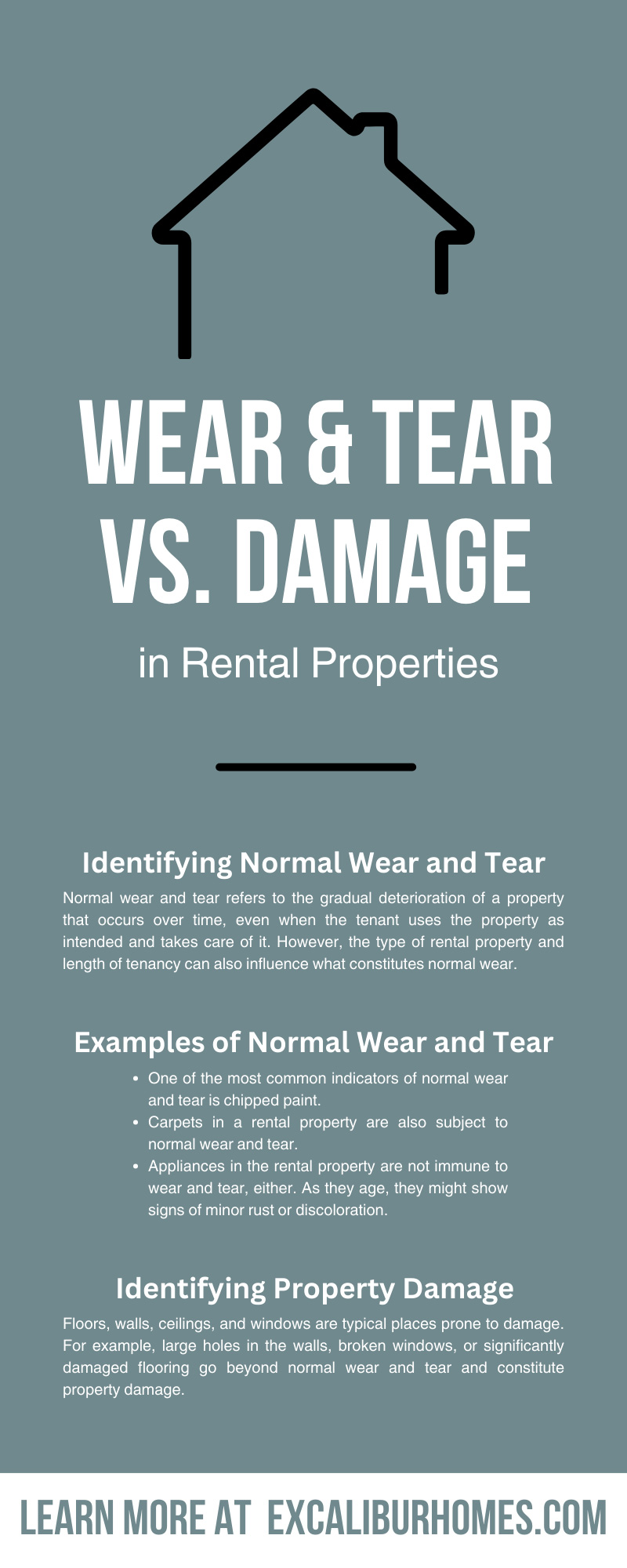
As a landlord or property investor, you know that owning and renting real estate comes with its ups and downs. You have to deal with special tax considerations, finding tenants, maintenance costs, tenant rules and regulations, and ensuring the property is safe and well maintained.
In particular, understanding the difference between normal wear and tear versus damage to rental properties is an important distinction any landlord or investor should be able to make. Knowing when your or your tenant’s actions have gone beyond what can be considered normal wear and tear helps protect your investment in the long run. It also helps ensure everyone is following the rules in the lease agreement.
Identifying Normal Wear and Tear
Normal wear and tear refers to the gradual deterioration of a property that occurs over time, even when the tenant uses the property as intended and takes care of it. However, the type of rental property and length of tenancy can also influence what constitutes normal wear. For example, a single-family home rented by a large family for many years will likely have more wear than a property with a shorter lease and fewer tenants.
External factors, such as weather conditions or the presence of children and pets, can also contribute to usual wear and tear. For example, in areas with harsh weather conditions, external paint might fade faster. Likewise, properties with children or pets might experience more wear on the flooring.
As a landlord or property manager, you must inspect each property thoroughly at the end of each lease. Document the condition of the property before the tenant moves in and compare it with the state of the property at the end of the lease. This process will help you differentiate between normal wear and tear and damage.
Providing a clear definition of both terms in the lease agreement can also help prevent disputes over security deposits. Keep in mind that it is not appropriate to use a tenant’s security deposit to repair issues related to normal wear and tear. Instead, reserve these funds for repairing actual damage the tenant caused.
Examples of Normal Wear and Tear
One of the most common indicators of normal wear and tear is chipped paint. Over time, with exposure to sunlight, moisture, and daily living activities, paint will chip or peel off slightly. Similarly, wallpaper may fade in color due to prolonged exposure to sunlight. These occurrences are typical and often unavoidable, even when tenants exercise great care in maintaining the property.
Carpets in a rental property are also subject to normal wear and tear. With regular foot traffic, carpets can become worn or faded. You should also expect the presence of minor indentations from furniture or light fading from sunlight.
Appliances in the rental property are not immune to wear and tear, either. As they age, they might show signs of minor rust or discoloration. The finish on kitchen appliances or bathroom fixtures may start to fade with regular use. This type of gentle wear is normal over time and is a part of the normal aging process of properties.
Identifying Property Damage
Unlike normal wear and tear, property damage is significant harm that affects the property’s value, usefulness, or normal function and is due to tenant negligence or abuse.
Floors, walls, ceilings, and windows are typical places prone to damage. For example, large holes in the walls, broken windows, or significantly damaged flooring go beyond normal wear and tear and constitute property damage.
Water damage is another common issue to look out for. Signs include discoloration on walls or ceilings, a musty smell, or the presence of mold. These signs often indicate a leak, which requires immediate attention.
Structural issues, such as cracks in the walls or ceilings, doors that do not close properly, or uneven floors, can also indicate serious property damage. Pest infestations are another sign of potential property damage and can be due to a lack of cleanliness on the tenant’s part. Look for signs such as droppings, chewed wires or furniture, or actual pests.
Even if the tenant didn’t cause the damage, it is their responsibility to report these issues as soon as they notice them. Failure to do so may put the responsibility on the tenant to repair the issue.
Landlord Responsibilities
Landlords bear a significant responsibility in maintaining their rental properties. This includes addressing both normal wear and tear and any property damage.
In terms of normal wear and tear or property damage that the tenant didn’t cause, landlords have an obligation to ensure the property remains habitable. They should regularly paint walls as they fade, replace carpets that show signs of wear, and repair any plumbing issues, such as leaky faucets. Plus, this proactive approach can prevent minor issues from escalating into more significant problems that may require costly repairs.
When property damage occurs due to a tenant’s negligence or misuse, their landlord must promptly document this damage. They should take photographs and write detailed descriptions of the damage. Once they have documented the damage, the landlord should discuss the issue with the tenant to decide the best course of action. Often, the cost of these repairs falls on the tenant, and the landlord can deduct the cost from the tenant’s security deposit if necessary.
However, landlords must also be aware of tenants’ rights. Tenants have the right to contest any charges they believe are unfair. Therefore, landlords should always communicate transparently with their tenants about these issues. Furthermore, landlords must respect their tenants’ right to quiet enjoyment of the property. This means landlords should schedule any inspections or repair work at times that are convenient for their tenants and provide them with adequate notice.
Tenant Responsibilities
For maintenance and upkeep, tenants should handle tasks such as replacing light bulbs, ensuring the cleanliness of the property, and verifying the proper functioning of smoke detectors. If a tenant notices any damages—whether they caused them or not—they should report the damages to their landlord as soon as possible. Leaving damage unrepaired can lead to more severe complications over time. This neglect may result in deductions from the security deposit or even instigate legal action in severe cases.
And finally, tenants bear responsibility for any significant damage inflicted on the property due to their own actions or the actions of their guests. In these instances, tenants must cover the cost of repairs.
Ultimately, the difference between normal wear and tear versus property damage in rental properties is that wear and tear is naturally occurring while property damage is not.
If you keep running into tenants who don’t respect your property or don’t report issues in a timely manner, Let Excalibur Homes help. We offer property management services in the Atlanta area and will help you find quality tenants. We’ll also help you manage maintenance repairs and requests so your investment stays in top shape.


